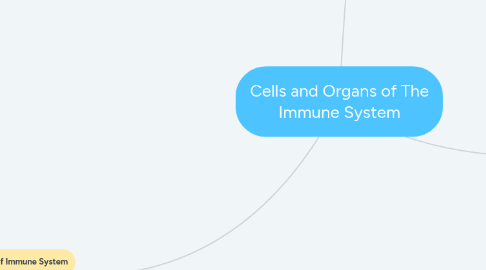
1. **Cells of Immune System**
1.1. Antigen-presenting cells (APCs)
1.1.1. capture and display antigens to lymphocytes
1.1.1.1. follicular dendritic cells display antigens to B lymphocytes
1.1.1.2. APC usually refers to cells that displays antigens to T cells.
1.1.1.2.1. macrophages present antigens to T cells during cell-mediated immune response.
1.1.1.2.2. B lymphocytes functions as APC for helper T cells during humoral response.
1.1.1.2.3. major type that involved in initiating T cell responses is dendritic cells.
1.2. effector cells
1.2.1. Cells that cause the final effect (lysis/ killing)
1.2.1.1. Eosinophils
1.2.1.1.1. -motile phagocytic cells, can migrate from blood into tissue spaces
1.2.1.2. Mast Cells
1.2.1.2.1. -can be found in many type of tissues
1.2.1.3. Macrophages
1.2.1.3.1. -when cells active, can secrete hydrolytic enzymes in the lysosomes of the macrphages
1.2.1.4. Neutrophils
1.2.1.4.1. -produced by hematopoiesis in the bone marrow
1.2.1.5. NK Cells
1.2.1.5.1. -involve in immune defenses against viruses and tumors
1.3. **Lymphocytes**
1.3.1. B Lymphocytes
1.3.1.1. arise and maturation in bone marrow
1.3.1.1.1. produce antibody
1.3.1.2. generating a population of plasma cells and memory cells
1.3.2. T Lymphocytes
1.3.2.1. arise in bone marrow and mature in thymus
1.3.2.2. **Helper T lymphocytes**: a) Stimuli for B cell growth and differentiation (humeral immunity) b) Macrophage activation by secreted cytokines (cell mediated immunity) c) There is two types: Th1 and Th2
1.3.2.2.1. activated by recognition of an antigen–class II MHC complex on an antigen-presenting cell.
1.3.2.3. **Cytolytic T lymphocytes**: Killing of virus-infected cells, tumor cells; rejection of allografts (cell-mediated immunity)
1.3.2.3.1. activated when they interact with an antigen–class I MHC complex on the surface of an altered self-cell
1.3.3. Naïve (small) lymphocyte
1.3.4. Large lymphocyte (lymphoblast)
2. Primary Lymphoid Organs (Provide appropriate microenvironments for **development & maturation** of lymphocytes)
2.1. **Thymus** : Site of T-cell development and maturation
2.1.1. **Cortex** : Densely packed with immature T cells (thymocytes) **Medulla** : sparsely populated with thymoctes
2.2. **Bone Marrow** : site of B cells origin and development
2.2.1. sites where immature B cells proliferate & differentiate, stromal cells within bone marrow interact with B cells & secretes **cytokines**
3. Secondary Lymphoid organs (**Trap antigen** from tissue or vascular spaces & sites where mature lymphocyte **interact with antigens**)
3.1. spleen
3.1.1. Specialized in filtering blood, trapping blood-borne antigens, respond to systemic infections
3.1.1.1. **Red Pulp** : sites where defective red blood cells are destroyed by macrophage
3.1.1.2. **White Pulp** : populated mainly by T lymphocytes
3.2. **Lymph Node**
3.2.1. -Follicles are the B cells zone of lymph nodes,
3.2.2. -Primary follicles contain mature & naive B lymphocytes,
3.2.3. -Germinal centers develop in response to antigenic stimulation
3.2.4. -sites of remarkable B cell proliferation, generation of memory B cells
3.2.5. -most of CD4+ helper T cells located in the cortex
3.2.6. -Dendritic cells concentrated in T cells zone
3.3. **Mucosal-Associated Lymphoid Tissue**
3.3.1. **Lamina Propia** : contain large number of B cells, plasma cells, activated Th cells and macrophages
3.3.2. **Peyer's Patches** : contained in the submucosal layer beneath lamina propia
3.3.3. Peyer's patches can develop into secondary follicles with germinal centers

